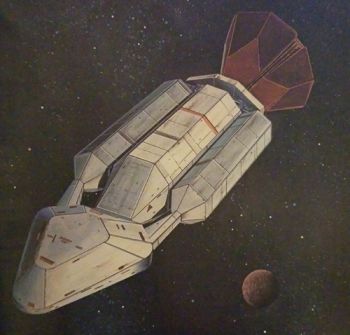Difference between revisions of "Cochrane class (21st Century) (FASA)"
m |
m |
||
| Line 160: | Line 160: | ||
[[Category:Ships & Vehicles]] | [[Category:Ships & Vehicles]] | ||
[[Category:UNSF Vessels]] | [[Category:UNSF Vessels]] | ||
| + | [[Category:Human Vessels]] | ||
[[Category:Human]] | [[Category:Human]] | ||
[[Category:Books]] | [[Category:Books]] | ||
Revision as of 05:46, 4 September 2019

Cochrane class (SFC)
Earth's first warp capable ship, the Cochrane class entered service in 2066, and proved to be the remarkable craft its designers had hoped it would be. After several years of design, construction, and testing, the Cochrane class, named for the inventor of the warp drive engine, Zefram Cochrane, inaugurated a new era in space exploration. Inacessible interstellar spans became reasonable distances, as demonstrated by the U.N.S.S. Bonaventure's journey to Tau Ceti in 2072, nearly 12 light years away. The class used fusion engines to generate the warp field effect, and featured a detatchable life support section in case of a warp engine emergency. The class was retired from service in 2104.[1]
Specifications
| Length | 206m |
| Beam | 63.4m |
| Draught | 66.7m
|
| Mass | 19.4 million kg |
| Ship's Complement |
|
| Navigation | Warp Celestial Guidance |
| Communication | Laser Radiotelemetry |
| Computer | Intermediate Independent Thought Memory Scan |
| Weapons | 2 forward lasers |
Performance
| Range (Standard) | 25 light years |
| Range (Maximum) | 40 light years |
| Velocity (Cruising) | Warp 1[2] |
| Velocity (Maximum) | Warp 1.5 |
| Typical Voyage Duration | 3.8 years (Sol-Tau Ceti) |
| Maximum Voyage Duration | 6 years |
| Life Support | |
| Sustenance Duration | 4.5 years at Standard Ship's Complement |
FASA Timeline

Cochrane class (SFC)
Earth's first warp capable ship, the Cochrane class entered service in 2058, and proved to be the remarkable craft its designers had hoped it would be. After nearly a decade of design, construction, and testing, the Cochrane class, named for the inventor of the warp drive engine, Zefram Cochrane, inaugurated a new era in space exploration. Inacessible interstellar spans became reasonable distances, as demonstrated by the U.N.S.S. Bonaventure's journey to Tau Ceti in 2061, nearly 12 light years away. The class used fusion engines to generate the warp field effect, and featured a detatchable life support section in case of a warp engine emergency. The class was retired from service in 2077.[1]
Specifications
| Length | 206m |
| Beam | 63.4m |
| Draught | 66.7m
|
| Mass | 19.4 million kg |
| Ship's Complement |
|
| Navigation | Warp Celestial Guidance |
| Communication | Laser Radiotelemetry |
| Computer | Intermediate Independent Thought Memory Scan |
| Weapons | 2 forward lasers |
Performance
| Range (Standard) | 25 light years |
| Range (Maximum) | 40 light years |
| Velocity (Cruising) | Warp 2 (8c) |
| Velocity (Maximum) | Warp 2.5 (15.6c) |
| Typical Voyage Duration | 3.8 years (Sol-Tau Ceti) |
| Maximum Voyage Duration | 6 years |
| Life Support | |
| Sustenance Duration | 4.5 years at Standard Ship's Complement |
Notes and References
- ↑ 1.0 1.1 Goldstein, Stan et al (Authors). Spaceflight Chronology. Star Trek. Book. Wallaby Books. 1980.
- ↑ Although Star Trek: Spaceflight Chronology established that the Cochrane class was capable of speeds in excess of Warp 2, this is explicitly contradicted in the Enterprise episode "First Flight," in which Commanders Jonathan Archer and A.G. Robinson are the first Humans to break the Warp 2 barrier in 2140. The speeds of the Cochrane class have been adjusted to reflect this.